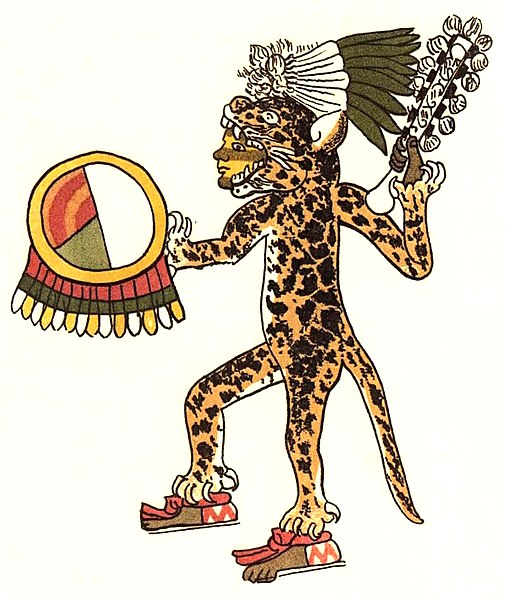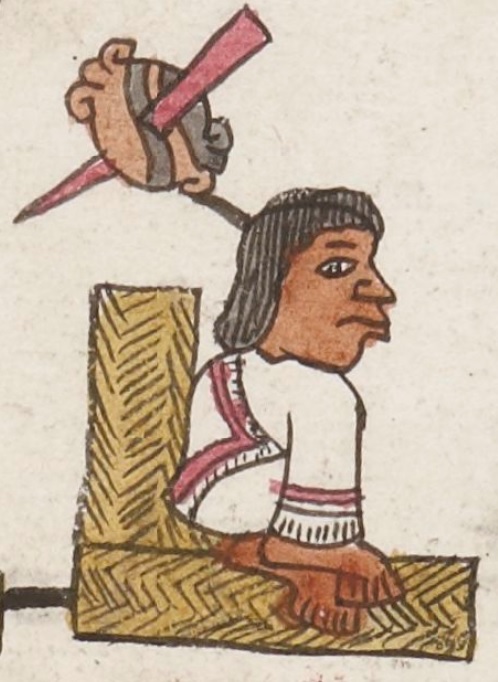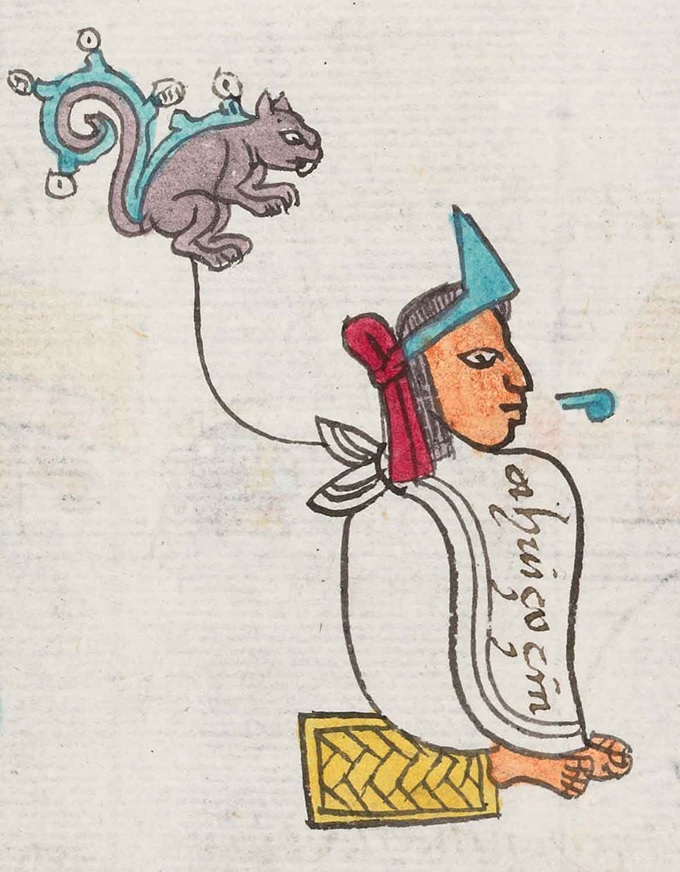 |
| Jaguar Warrior |
Elite Warriors
There were
two groupings of elite warriors; the cuauhchique[i]
and the otontin or Otomies to which the feared Eagle Warriors and the Jaguar Warriors belonged. The tlacochcalcatl[ii] along with the other four members of
the military council[iii],
the tlaccatecatl, the etzhuanhuanco and the tillancalqui were all members of one or
the other order.
To be
admitted within the ranks of these two orders a warrior must have committed
twenty or more deeds of valour and captured a number of prisoners for
sacrifice. The elite were permitted to wear feather jewellery and cotton
clothing as marks of their standing in society as well as drink pulque[iv] in public, keep courtesans and dine
in the palace. One chronicle relates that announcements of yet another war was an
event greeted by pleasure; by the warriors
‘Everyone was glad to go to
war, that no more warriors remained in the cities, for all wanted to go to war
since they fared so well in it.’[v]
The Aztecs
did not have a standing army but each calpulli
was required to contribute 400 men. The unit marched under its own standard
commanded by community leaders. The army’s basic unit was 8,000 men and long
distance expeditions would include porters for supplies and equipment
contributed by subordinate towns.
The Short Reign of Tlatoani Tizoc
 |
| Tizoc |
Tizoc had
been tlacochcalcatl to Axayacotl and he now came to power in the year Two House (1481)[vi]
following his brother’s death. He made his brother Ahuitzotl his tlacochcalcatl. Tizoc’s coronation war was a dismal failure, producing very little in the way of
prisoners for sacrifice.
Metztitlan was the chosen objective, 125 miles
away from the heart of the empire. The resultant battle was saved by a
formation of teenage warriors who took 40 prisoners. Tizoc’s coronation went
ahead but the meagre display of sacrifices was viewed as an unfavourable omen.
Tizoc’s future wars were not ones of conquest but repressing rebellions against
Aztec rule. As his reign continued the empire faced increasing sedition,
aggression and rebellion.
Tizoc
started the extensive rebuilding of the Great Temple of Tenochtitlan[vii],
the rebuilding was to be finished during the reign of his younger brother.
There are rumours that Tizoc was poisoned which was not unusual for a highly
contested position, particularly that of Tlatoani of the Triple Alliance. It is
possible that Ahuitzotl was involved in bringing his brother’s reign to an end.
Four days after Tizoc’s death the elective council met and chose the ambitious
Ahuitzotl as the next Tlatoani of the Aztecs.
The Coronation of Ahuitzotl
 |
| Ahuitzol |
Ahuitzotl
became Tlatoani in year Seven Rabbit (1486). He was relatively young to become
Tlatoani, being barely out of his teens. He took the name Ahuitzotl[viii]
and was to prove himself a warrior par excellence, living and fighting with his
men. He inspired his soldiers with his own personal valour.
After his
election and a four day period of retreat of fasting and penitence, Ahuitzotl
was taken before the Great Pyramid where, in front of a silent crowd, he was stripped
down to his loincloth, he was led up the pyramid by the Tlatoani of Texcoco and
Tlacopan. At the summit, in the shrine to Huitzilopochtli, Ahuitzotl was
dressed in a dark green robe decorated with skulls. He then burned incense in
the god’s honour and descended the pyramid.
Ahuitzotl
led the crowd to one of the palaces where the Tlatoani of Texcoco, Nezhualpilli, dressed
him;
 |
| Nezhualpilli |
‘In a robe of shining fabric
with a glistening waistband, solemnly placed a greenstone crown on his head and
adorned him with fabulous jewellery including emerald earrings and nosepiece, gold
armbands and anklets, and jaguar skin sandals. He led him to a splendid throne
covered with jaguar skins and eagle feathers.’[ix]
Next came a
public ceremony; Ahuitzotl was carried on a litter back to the Templo Mayor
where at Huitzilpochtli’s shrine he used jaguar claws to let his own blood[x]
and offered quails as a sacrifice. Further sacrifices were made to the sun. Ahuitzotl
was then carried on his litter to the coateocalli[xi]
where he made further blood sacrifices. He then carried on to a temple
dedicated to the earth and spring planting where he once again gave his blood
to the god.
Finally Ahuitzotl
returned to the palace where a series of speeches gave him to understand that
he was now raised above his fellow man for he was imbued with the powers of the
gods. As leader of his people Ahuitzotl now had the power to speak to the gods
and was their embodiment on earth.
Coronation War
 |
| Tlaxcolotongo Falls near Xicotepec |
Ahuitzotl
was tough and fearless, proving himself to be Tenochtitlan’s most fearsome
leader; he lived and fought with his men on campaign. His campaigns were short,
sharp and brutal and Ahuitzotl took murderous retribution against his enemies.
The coronation war was a circuit into the Toluca valley and then northward to Xicotepec, before turning to the northern Valley of Mexico.
The fighting
killed two birds with one stone; Ahuitzotl suppressed the rebellious cities and
reasserted the Tlatoani’s dominion over the army which had become demoralised
in Axayacatl’s declining years and under Tizoc’s lacklustre leadership. The
booty Ahuitzotl and his army collected on their foray was equal to one year’s
tribute. Almost immediately Ahuitzotl marched out on a second punitive campaign
to the Gulf Coast, where many cities had refused to send tribute.
Conquered
realms were forced to send tribute every year and altogether Tenochtitlan
received 123,000 cotton[xii]
blankets from its tribute cites annually. Other goods sent as tribute included
enough food to feed 360,000 people per annum[xiii],
food, gold, silver, precious stones, armour made of feather and cotton, rubber,
rubber balls, cotton, cotton textiles and worked products. Everything had to be
carried on the back of porters as there were no draught animals.
This wealth
was recorded and then stored in special depositories; much of it was used to
venerate the gods. For cities close to the empire labour was also a form of
tribute demanded by the victors.
Commemoration of the Tlatoani
| Resplendent Quetzal |
Following
his successful coronation war Ahuitzotl had plenty of prisoners to sacrifice
and he used them both to commemorate the completion of the Great Temple’s
reconstruction in Eight Reed (1487) but also as the final sequence in the
rituals that confirmed him as Tlatoani.
The
commemoration festival lasted four days. On the first day, to demonstrate the
primacy of Tenochtitlan within the Triple Alliance, Ahuitzotl presented the
Tlatoani of Texcoco and Tlacopan with symbols of their status and then the
three leaders led a 2,000 strong company of nobles and warriors in a stately
dance. He then made a triumphant entrance in a costume adorned with quetzal feathers and jewellery and was surrounded by the dancers. Ahuitzotl made
formal presentation of the insignia of office to the officials surrounding him,
to underline his pre-eminence.
‘All the gentry of the
neighbourhood were invited….the calpixques[xiv]
and administrators….brought together all the necessaries for the feast….The
ruler himself arrayed the nobles in rich blankets, and he told them this was
the reward for their brave deeds.’[xv]
The final part of the commemoration was the sacrifices.
Between 20,000 and
80,000 victims[xvi]
are alleged to have been killed in what one chronicler described as;
‘Butchery….without equal in
human history.’[xvii]
Tlacealel, as cihuacoatl[xviii], dedicated the seventh reconstruction of the Templo Mayor but it was Ahuitzotl himself who made the
first sacrifice, attended by his co-rulers of Texcoco and Tlacopan. He cut out
the victim’s heart with his obsidian blade, holding it up to the sky before
making his obeisances to the new temples. In accordance with custom the body
was then thrown down the temple steps before the army of priests in attendance
took over the remainder of the killings which took four days to complete.
Bibliography
The Ancient
Kingdoms of Mexico – Nigel Davies, Penguin 1985
The New
World – Nicholas Hordern, Aldus Books/Jupiter Books 1971
The Ancient
American Civilisations – Friedrich Katz, Phoenix Press 2000
Moctezuma
and the Aztecs – Elisenda Vila Llonch, the British Museum Press 2009
The
Illustrated Encyclopedia of the Aztecs and Maya – Charles Phillips, Hermes
House 2010
The Aztecs –
Richard F Townsend, Thames & Hudson Ltd 2010
www.wkipedia.en
[i]
The shaved ones
[ii]
Master of the House of Darts or General
of the Army; often a last promotion before being elected Tlatoani. Tizoc had
been Axayacatl’s Tlacochcalcatl
[iii]
Usually close relatives of the Tlatoani
[v]
Ancient American Civilisations - Katz
[vi].The
year Two House was the anniversary of the foundation of the empire, which was
believed to foreshadow the fall of the empire
[ix]
The Illustrated Encyclopedia of the Aztecs and Maya – Phillips
[x]
‘Made to the earth as a sign of truth and a bond with the land he was to
govern’ – Townsend p. 106
[xi]
Holding the statues of gods captured from conquered cities
[xii]
Cotton was especially prized by the peoples of central America
[xiii]
The cities paying a food tribute were those closest to the Aztec empire, while
more far-flung lands contributed textiles
[xiv]
Stewards who oversaw conquered lands
[xv]
Ancient American Civilisations - Katz
[xvi]
Allegedly making four lines that stretched for over four kilometres; although
Davies suggests that these figures do not take account of the Aztec method of
calculating and that the figure was probably closer to 4,000
[xvii]
The Illustrated Encyclopedia of the Aztecs and Maya – Phillips
[xviii]
Following Tlacaelel’s death later in 1487 his successor as cihuacoatl
was his son Tlilpotonqui
.jpg/569px-Codex_Magliabechiano_(141_cropped).jpg)
No comments:
Post a Comment
Note: only a member of this blog may post a comment.